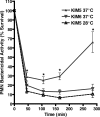Yersinia pestis type III secretion system-dependent inhibition of human polymorphonuclear leukocyte function
- PMID: 18490459
- PMCID: PMC2493194
- DOI: 10.1128/IAI.00385-08
Yersinia pestis type III secretion system-dependent inhibition of human polymorphonuclear leukocyte function
Abstract
Human polymorphonuclear leukocytes (PMNs, or neutrophils) are the primary innate host defense against invading bacterial pathogens. Neutrophils are rapidly recruited to sites of infection and ingest microorganisms through a process known as phagocytosis. Following phagocytosis by human PMNs, microorganisms are killed by reactive oxygen species (ROS) and microbicidal products contained within granules. Yersinia pestis, the causative agent of plague, is capable of rapid replication and dissemination from sites of infection in the host. Although Y. pestis survives in macrophages, the bacterial fate following interaction with human PMNs is less clear. The ability of Y. pestis to inhibit phagocytosis by human PMNs was assessed by differential fluorescence microscopy and was shown to be dependent on expression of the type III secretion system (TTSS). Previous studies have demonstrated that TTSS expression in enteropathogenic Yersinia spp. also inhibits the respiratory burst in PMNs and macrophages, and we show here that human PMN ROS production is similarly repressed by Y. pestis. However, exclusion of uningested TTSS-expressing Y. pestis with gentamicin revealed that intracellular bacteria are eliminated by human PMNs, similar to bacteria lacking the TTSS. In summary, our results suggest that the Y. pestis TTSS contributes to extracellular survival following interactions with human PMNs and that the intracellular fate is independent of TTSS inhibition of neutrophil ROS production.
Figures




Similar articles
-
Yersinia pestis survival and replication within human neutrophil phagosomes and uptake of infected neutrophils by macrophages.J Leukoc Biol. 2014 Mar;95(3):389-98. doi: 10.1189/jlb.1112551. Epub 2013 Nov 13. J Leukoc Biol. 2014. PMID: 24227798 Free PMC article.
-
Characterization of Yersinia pestis Interactions with Human Neutrophils In vitro.Front Cell Infect Microbiol. 2017 Aug 9;7:358. doi: 10.3389/fcimb.2017.00358. eCollection 2017. Front Cell Infect Microbiol. 2017. PMID: 28848716 Free PMC article.
-
Inhibition of Neutrophil Primary Granule Release during Yersinia pestis Pulmonary Infection.mBio. 2019 Dec 10;10(6):e02759-19. doi: 10.1128/mBio.02759-19. mBio. 2019. PMID: 31822588 Free PMC article.
-
Immunology of Yersinia pestis Infection.Adv Exp Med Biol. 2016;918:273-292. doi: 10.1007/978-94-024-0890-4_10. Adv Exp Med Biol. 2016. PMID: 27722867 Review.
-
Turning Yersinia pathogenesis outside in: subversion of macrophage function by intracellular yersiniae.Clin Immunol. 2005 Mar;114(3):216-26. doi: 10.1016/j.clim.2004.07.013. Clin Immunol. 2005. PMID: 15721832 Review.
Cited by
-
The Lon protease is essential for full virulence in Pseudomonas aeruginosa.PLoS One. 2012;7(11):e49123. doi: 10.1371/journal.pone.0049123. Epub 2012 Nov 7. PLoS One. 2012. PMID: 23145092 Free PMC article.
-
Role of Yersinia pestis toxin complex family proteins in resistance to phagocytosis by polymorphonuclear leukocytes.Infect Immun. 2013 Nov;81(11):4041-52. doi: 10.1128/IAI.00648-13. Epub 2013 Aug 19. Infect Immun. 2013. PMID: 23959716 Free PMC article.
-
Yersinia pestis can bypass protective antibodies to LcrV and activation with gamma interferon to survive and induce apoptosis in murine macrophages.Clin Vaccine Immunol. 2009 Oct;16(10):1457-66. doi: 10.1128/CVI.00172-09. Epub 2009 Aug 26. Clin Vaccine Immunol. 2009. PMID: 19710295 Free PMC article.
-
Yersinia pseudotuberculosis virulence determinants invasin, YopE, and YopT modulate RhoG activity and localization.Infect Immun. 2009 Nov;77(11):4771-82. doi: 10.1128/IAI.00850-09. Epub 2009 Aug 31. Infect Immun. 2009. PMID: 19720752 Free PMC article.
-
Gr1+ cells control growth of YopM-negative yersinia pestis during systemic plague.Infect Immun. 2009 Sep;77(9):3791-806. doi: 10.1128/IAI.00284-09. Epub 2009 Jul 6. Infect Immun. 2009. PMID: 19581396 Free PMC article.
References
-
- Allen, L. A. 2003. Mechanisms of pathogenesis: evasion of killing by polymorphonuclear leukocytes. Microbes Infect. 51329-1335. - PubMed
-
- Allen, L. A., B. R. Beecher, J. T. Lynch, O. V. Rohner, and L. M. Wittine. 2005. Helicobacter pylori disrupts NADPH oxidase targeting in human neutrophils to induce extracellular superoxide release. J. Immunol. 1743658-3667. - PubMed
-
- Bengoechea, J., B. Lidner, U. Seydel, R. Diaz, and I. Moriyon. 1998. Yersinia pseudotuberculosis and Yersinia pestis are more resistant to bacterial cationic peptides than Yersinia enterocolitica. Microbiology 1441509-1515. - PubMed
Publication types
MeSH terms
Substances
Grants and funding
LinkOut - more resources
Full Text Sources
Miscellaneous

